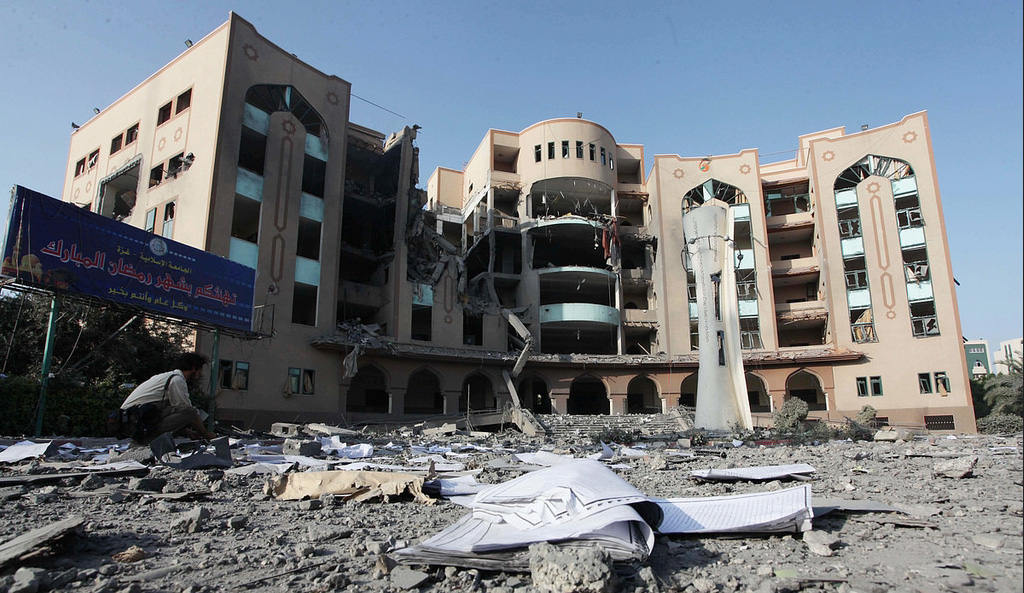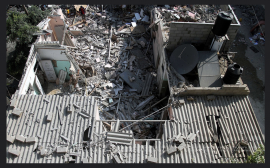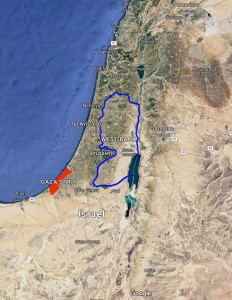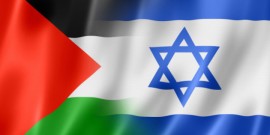Life in Gaza: An Education to Die For

A young woman is huddled around a small battery operated radio with her family.
The lantern lights flicker in the dark pools of her eyes and a pale pink hijab covers her head.
The electricity is shut off again and the darkness threatens to swallow the family whole. They listen to the news, waiting anxiously for any indication that life will get better.
That’s when the bombs fell from the sky.
The air is ripe with smoke and dust. The screams of her neighbors fill her ears. Buildings, once home to families, lay in mangled, twisted heaps of metal and concrete.
Enaya was only nineteen when Israel began its bombing campaign in Gaza in 2014. The images of that day are still burned in her mind.
After the bombing, she didn’t eat for three days.
Enaya, whose name the Pioneer has changed to protect her from the threat of violence, continues to live with that trauma. She fears for the safety of her and her loved ones. That’s because they still live in what the locals call “the world’s largest open-air prison.”
During the same time in 2014 when her neighborhood was attacked, Enaya’s school, The Islamic University of Gaza, was bombed. Eventually, she was able to return to the university to finish her Bachelor’s in Psychology because that portion of the school remained intact.
“In the end, the university held a huge graduation ceremony. It was the best day of my life,” she said.
In Gaza, there are few paid jobs available. She uses what she has learned to volunteer with children suffering from post-traumatic stress disorder and other behavioral issues related to war. Despite having her degree, she knows that she needs more education and training to adequately help the children she works with.
“The biggest issue I have is that I am not able to leave Gaza to study abroad for my Master’s degree.” she said.
As Enaya struggles to continue her education to help the children of Gaza, another woman was able to acquire hers.
Resting under a delicate blue head scarf, intense brown eyes peek out from behind spectacles. They tell the story of twenty-two-year-old Laila, whose name has also been changed by the Pioneer to protect her from the threat of violence.
In 2015, Laila was awarded the International Fulbright scholarship. According to the U.S. State Department, the Fulbright Program is the “flagship international educational exchange program.” The scholarship was created to “increase mutual understanding between the people of the United States and the people of other countries.”
“My scholarship was from the American consulate and they helped me get the Israeli permit to leave,” Laila said.
Once the Israeli consulate approved her permit, she began the precarious journey to the Israeli border from Gaza City. She was terrified of being killed on the way.
The short journey is marked by the risk of bombs and missile attacks.
“You don’t know whether the car beside you or maybe the car you are in will be bombed,” she said
Despite her fears, Laila made it to the border checkpoint. But the Israeli government turned her away.
“They told me no, you will not travel, even though I had the permit. Maybe they were busy preparing the war for us.”
Her only option was to travel to the Egyptian border crossing at Rafah. The young woman admitted that, secretly, she was praying to not be allowed to cross the border.
“I was thinking that my family was going to die while I am gone. I wanted to die with them if that happens,” she said.
Laila was shocked that she was able to pass into Egypt.

She said, at the time, the only people allowed to cross at Rafah were those with critical illnesses who had a foreign passport.
She had neither.
After crossing the border, she took a taxi alone across the politically unstable Egyptian desert into Cairo.
Eventually, in spite of the dangers, Laila made it onto American soil.
The International Women’s Travel Center has ranked Egypt at the fourth most dangerous country for a woman to travel through because of threats of terrorism and high rates of rape, kidnapping, and robbery.
Because of the delays, she missed her pre-academy training program and the first two weeks of class. After an adjustment period, she began to thrive in her temporary home. She joined clubs, made friends, and good grades.
In the back of her mind though, she knew that soon she would have to go back to Gaza.
The thought of returning was gut-wrenching.
“Dreams and goals are fading away from the youth in Gaza,” she said. “The situation just kills everything. The two years I lived in the U.S. are the only years of my life that I have lived. In the U.S., people can tame their passions. I just feel like dying.”
After spending two years in the U.S. and earning a master’s degree, Laila returned to Gaza. Today, she works as an English teacher, but she still wants more for herself and the people of Gaza.
The stories of Enaya and Laila only begin to scratch the surface of life in the Gaza Strip.
According to the Council on Foreign Relations, a U.S.-based nonpartisan think tank, the modern Israeli-Palestinian conflict can trace its roots back to the late nineteenth century. Jews fleeing persecution believed that the only way to ensure their safety was to establish a permanent national homeland.
The land they chose was also home to an Arab-Muslim majority population.
Muslims and Jews all have significant ties to this swath of land because of the multiple religious holy sites located in Jerusalem. Many of the sites are significant to both Islam and Judaism.
The Temple Mount in Jerusalem was home to the first Jewish Temple. This temple was supposed to contain the Ark of the Covenant, an artifact believed by Jews to hold the Ten Commandments.
For Muslims, the Temple Mount is called Haram al-Sharif and is home to al-Aqsa Mosque. Outside of Mecca, it is one of the most sacred sites in all of Islam. The Mosque is the site of the Dome of the Rock an Islamic holy shrine.
The Western Wall is another contested holy site. Located at the foot of the Temple Mount, the wall once supported part of the ancient Jewish temple.
Control of these sites, along with many others, have fueled disputes between the two religions. In 1947, the United Nations stepped in and voted to split the land into two countries: Israel and Palestine.
This plan failed and in 1967, during the Six-Days War, Israel claimed victory over the two remaining Palestinian territories the West Bank and the Gaza Strip. These two separate plots of land are recognized as one territorial unit.
After the Six-Days War, the Israeli military occupied Gaza and the West Bank. In 2005, Israel pulled its troops out of Gaza but left them in place in the West Bank.
Since that time, Israel has been building Jewish settlement communities in the West Bank, depriving the Palestinians of their land. Despite international pressure from the United Nations to cease construction of the settlements, Israeli development continues.
Although no longer under Israeli occupation, the situation in Gaza is even more perilous for the Palestinian people. This is because of Israeli enforced blockade restrictions on the territory.
According to a 2016 report from the United Nations Office for the Coordination of Humanitarian Affairs, 1.9 million Palestinians are ‘locked in’ Gaza. Restrictions imposed by Israel have “fragmented the economic and social fabric” of the region.
The result is high levels of unemployment, food and energy shortages, and dependency on outside humanitarian aid. This has deprived the Gazan people of quality health care, education, sanitation services.
Itai Bardov, Spokesman for the Israeli Embassy in Washington D.C. said “there is no land blockade on Gaza. Access to Gaza from the sea is blocked, but not entry through its land crossings. All goods are allowed to enter Gaza from Israel, except for weapons and a short list of dual-use items which can be exploited by terrorists.”
He said that these restrictions are necessary to protect the people of Israel from “ongoing daily rockets and mortar fire attacks.”
Bardov cited a 2010 United Nations report as justification for Israeli restrictions placed on Gaza. The report found the Israeli blockade legal. However, not all members of the four person investigation panel agreed.
One member, Turkish government representative Süleyman Özdem Sanberk condemned the panel’s findings.
In his written dissent, Sanberk condemned the findings because the three other panel members refused to consider contradictory findings from the Turkish government and many in the international community.
“Common sense and conscience dictate that the blockade is unlawful,” he wrote.
At a 2014 Human Rights Council Special Session, UN High Commissioner for Human Rights Navi Pillay agreed.
She said there is “a strong possibility that international humanitarian law has been violated, in a manner that could amount to war crimes.”
The Council demanded that “Israel immediately and fully end its illegal closure of the occupied Gaza Strip.”
- Abdelhady, a representative of Hamas, said that, “the miserable situation [in Gaza] is to put more pressure on people in order to blackmail Hamas. We believe that the attacks by Israeli against Gaza are not justified. The deteriorating situation in Gaza is dangerous and they aim to increase the suffering of the civilians.”
For some living in Gaza, Hamas is viewed favorably because of its social welfare program and rebuilding efforts of schools and hospitals.
However, many others fear the group because of broad sweeping imprisonment and execution of dissenters and restrictions on free speech.
Groups including the U.S. State Department and the European Union have classified Hamas as a terrorist organization. This is due to its use of military tactics including suicide bombers and political kidnappings. It is compounded by Israeli accusations of high-level corruption within the group.
In its 1988 charter, Hamas identified itself as a branch of the Muslim Brotherhood, a radical fundamentalist group that the U.S. State Department has labeled as a terrorist organization.

According to the document’s preamble, “Israel will exist and will continue to exist until Islam will obliterate it, just as it obliterated others before it.”
It is because of this stance that Israel is unwilling to acknowledge Hamas as a legitimate governmental entity.
Earlier this year, Hamas updated its controversial charter and softened its tone towards Israel and renounced its affiliation with the Muslim Brotherhood.
According to the British newspaper, the Guardian, Israel has rejected the new document.
In the article, a spokesman for Israeli prime minister, Benjamin Netanyahu said: “Hamas is attempting to fool the world, but it will not succeed.”
Because of the continued conflict between Israel and Hamas, the reality for civilians living in Gaza remains tumultuous.
A U.N. report released in July 2017 said: “There is little to celebrate [in Gaza] as, by the end of this year, the only water source will be depleted, and irreversibly-so by 2020, unless immediate remedial action is taken.”
It is not just a lack of fresh drinking water that threatens the citizens of Gaza. The report highlights the deteriorating conditions of Gaza’s educational system.
Although the report said Gaza has a literacy rate of 97 percent, it finds that this level of literacy is not sustainable. This is because during the Israeli-Hamas war of 2014, 547 educational facilities, were damaged or destroyed.
With the help of Hamas and several humanitarian aid groups, many of the schools have since been repaired. However, 181 kindergartens and 11 higher education institutions are still unusable.
The rebuilding efforts have been hampered because many of the Israeli restricted items include building materials. The U.N. study estimates that to keep up with the sharp spike in population growth, 900 new schools will need to be built.
Even if the new schools are built, the Gazan population lacks a sufficient number of trained teaching personnel. To accomplish this would require increased opportunities to travel abroad for teacher training.
With Israeli restrictions still in place, this is not possible.
There is a sliver of hope for the people of Gaza.
On Sunday, July 23, the Associated Press reported that Hamas and Egypt are currently negotiating the opening of the Egyptian land border with Gaza. This would ease Gaza’s electricity and resource shortages.
Although the border opening is scheduled for late August, negotiations are still in the early stages and are not guaranteed.
In the meantime, the people of Gaza are caught in the cross hairs of two conflicts.
“It’s a very sad situation. It’s not only the Israeli-Palestinian situation. It’s the Hamas-Fatah situation. It’s a boiling pot ready to boil over,” said Dr. Sharon Vaughan, an Oklahoma City Community College Political Science professor.
In 2006, Hamas participated in democratic elections for the first time. To the shock of many in the international community, they won a majority of seats in the Palestinian Legislative Council. Rival political group Fatah, the former majority party was now the minority.
The two formed a coalition government to oversee both Gaza and the West Bank. The new coalition left Fatah’s Mahmoud Abbas to continue his presidency and Hamas member Ismail Haniyeh as prime minister.
Just one year later, Fatah President Abbas dissolved the coalition government, declared a state of emergency and seized power from Hamas.
The democratically elected Hamas now only had authority in Gaza.
Since then, the two rival political groups have been unable to agree on how best to govern the two territories. This fragmentation has weakened both groups creating more hardships for the Palestinians.
Caught in this multifaceted conflict, people like Laila and Enaya continue to suffer the repercussions. The two young women are doing what they can to make Gaza a better place.
Laila is an English teacher and Enaya is a children’s mental health volunteer. They both know that education is the key to solving many of the territories problems.
However, they also know that the uphill struggle of it all threatens to stop them dead in their tracks.
“People are getting used to living in this crisis. They are starting to think this is normal. We surely can not bring about change by being complacent to this situation,” Laila said.

If you are interested in helping the people of Gaza donations can be made to the United Nations Relief and Works Agency for Palestinian Refugees in the Near East www.unrwa.org/gaza-emergency